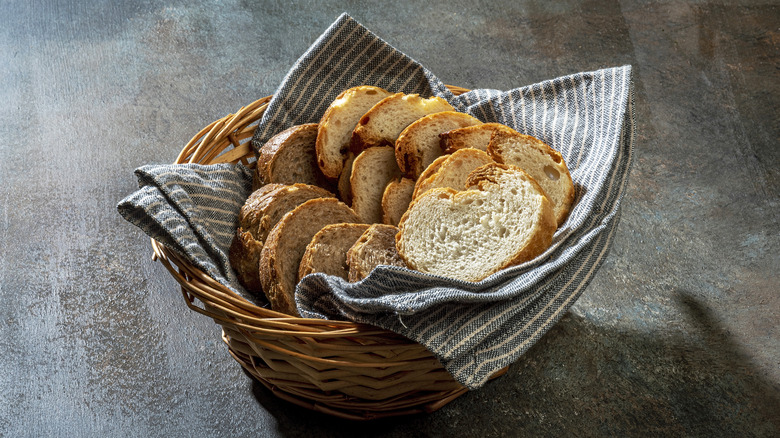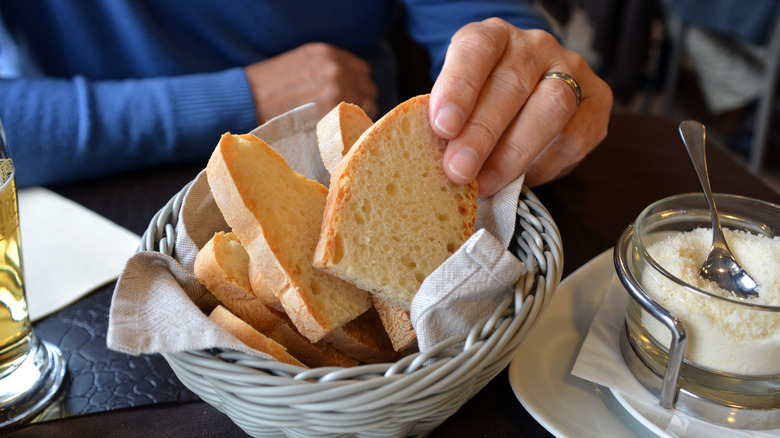The Sneaky Reasons Restaurants Give You Free Bread
If there's no such thing as a free lunch, why do some restaurants give out free bread to customers? It seems like the epitome of getting something for nothing — though in reality, restaurants probably do it because they think it benefits them (either financially or in terms of their reputation). There are various theories about why free bread might help restaurants, but take note that they're just theories. Beyond some pop psychology, there's not much established science around this topic — but whether or not these reasons are scientifically valid, the point is that some restaurant owners may believe in them enough to pop down baskets of free rolls.
One common explanation is that bread makes restaurants look good. Some say that the free bread simply reflects a restaurant's commitment to generous hospitality, while others suggest that it's to give hungry customers something to eat while they wait for their order. Either way, the logic is that free bread is an indirect benefit, giving customers something they like so they're more likely to write nice reviews online or recommend the establishment to friends.
It's even been argued that generosity in the form of free bread will prompt customers to turn around and be generous back to the restaurant, presumably by ordering more food. While there's some substance to the idea that generosity begets generosity in its abstract form, it's unclear if it would apply in a transactional setting like a restaurant.
Why some believe free bread is good for a restaurant's bottom line
There are theories that free bread could actually make diners spend more. One argument is that simple carbohydrates in white bread would cause a blood-sugar spike that makes you feel more hungry as you peruse the menu, in turn leading you to order more. The science here is a bit hazy: Simple carbs are digested faster, making you hungry sooner — but perhaps not immediately, as this idea implies. Diners often dismiss this idea on the fairly logical basis that filling up on bread would make you spend less, but it's repeated enough in the media that there could be restaurant owners who buy into it. Even if it's correct, the idea doesn't work as well if a restaurant serves whole wheat, as it's a complex carb that wouldn't cause the same blood-sugar spike.
A more straightforward theory is that free bread allows restaurants to get away with smaller portion sizes: If you fill up on (cheaper-to-make) bread, you won't want to eat as much of a more expensive entree. This means a restaurant could shrink the portions and save money on expensive ingredients like meat.
Free bread is on the decline, though
While there's a lot of relatively untested theories about the benefits that free bread can bring to a restaurant, there's one very easily measured downside for them: It costs money. A large restaurant's bread bills could run multiple thousands of dollars each year. Even if free bread does bring in, say, a few extra positive Google reviews, or if it gets some diners out of the restaurant faster because they didn't buy dessert, it's still a substantial expense in an industry known for very low profit margins.
So, it seems that free bread baskets are generally in decline, with restaurants either ditching them completely, charging for bread, or sometimes only offering free bread on request. Cost is probably the main reason, although concerns around food waste are likely speeding up the demise of free bread. It probably didn't help that Anthony Bourdain's hugely popular book Kitchen Confidential accused the restaurant industry at large of recycling uneaten bread from bread baskets. While this likely doesn't happen much at all, the idea has stuck around, perhaps putting customers off free bread, too. But in any case, free bread is far from extinct: There are still plenty of chain restaurants that offer it fairly generously.


